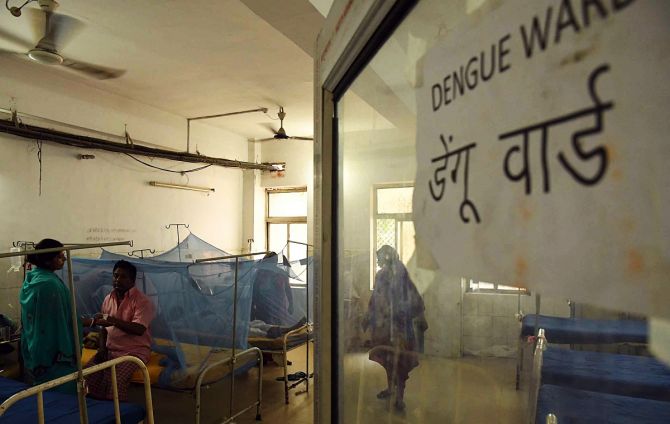Bihar Battling Dengue Surge: 6,146 Cases in September, Highest in 5 Years

Bihar Battling Dengue Surge: 6,146 Cases in September, Highest in 5 Years
In a concerning turn of events, Bihar, one of India’s eastern states, is grappling with a significant surge in dengue fever cases. According to official data, September 2023 witnessed an alarming 6,146 reported cases of dengue, marking the highest incidence for this month in the past five years. This surge in cases has raised a red flag, as health authorities and communities struggle to combat the rapid spread of the mosquito-borne disease.
Dengue fever, caused by the Aedes mosquito-borne dengue virus, is a debilitating illness characterized by symptoms such as high fever, severe headaches, joint and muscle pain, and in severe cases, hemorrhagic fever, which can be life-threatening. The surge in dengue cases in Bihar has set off alarm bells among health officials, as the state grapples with a health crisis of unprecedented proportions.
A Disturbing Trend Unfolds
The latest statistics reveal that Bihar has reported a total of 6,421 dengue cases in the year 2023 alone. The overwhelming majority of these cases, a staggering 6,146, emerged just in the month of September. This represents a three-fold increase compared to the 1,896 cases recorded in September of the previous year, underlining the severity of the situation.
On a single day in September, specifically a Friday, Bihar reported a distressing 416 new cases of dengue. These numbers underscore the urgency of the situation and the need for immediate action to curb the outbreak.

Factors Fueling the Dengue Surge
Several factors contribute to the alarming rise in dengue cases in Bihar. Understanding these factors is crucial in formulating an effective response to the crisis:
1. Climate and Weather Patterns: Dengue outbreaks are often associated with the monsoon season due to the favorable breeding conditions for Aedes mosquitoes. Bihar, like many parts of India, experiences a monsoon season characterized by heavy rainfall and stagnant water, creating ideal breeding grounds for mosquitoes.
2. Urbanization: Rapid urbanization in Bihar has led to increased population density and the proliferation of unplanned settlements. These urban areas often lack proper sanitation and drainage systems, further facilitating mosquito breeding.
3. Lack of Awareness: A lack of awareness about preventive measures and delayed medical care-seeking behavior among the population contributes to the rapid spread of the disease.
4. Health Infrastructure Challenges: The state’s healthcare infrastructure faces challenges in terms of capacity, resources, and accessibility, making it difficult to manage the increasing number of dengue cases effectively.

Government Response and Measures Taken
In response to the dengue outbreak, the Bihar government has initiated several measures to control its spread and provide relief to affected individuals. Some of the key steps taken include:
1. Intensified Vector Control Measures: Authorities have ramped up efforts to control mosquito breeding by conducting extensive fogging, spraying larvicides in stagnant water bodies, and implementing mosquito control programs.
2. Public Awareness Campaigns: Public health campaigns have been launched to educate residents about dengue prevention measures, such as maintaining clean surroundings, using mosquito nets, and seeking medical care at the first sign of symptoms.
3. Strengthening Healthcare Infrastructure: The government is working to strengthen healthcare facilities and ensure the availability of dengue-specific treatments and medical staff.
4. Surveillance and Monitoring: Enhanced surveillance systems have been put in place to closely monitor the spread of the disease and respond swiftly to new cases.
The Role of Community Engagement
While government efforts are crucial, community engagement and individual responsibility are equally important in combating the dengue outbreak. Communities can play a vital role by:
1. Eliminating Breeding Sites: Residents can actively participate in mosquito control by eliminating stagnant water sources around their homes and neighborhoods.
2. Seeking Timely Medical Care: It is essential for individuals to seek medical attention promptly if they experience dengue symptoms, as early diagnosis and treatment can significantly improve outcomes.
3. Spreading Awareness: Community members can help raise awareness about dengue prevention measures among their peers and neighbors.

The Way Forward
As Bihar grapples with the highest number of dengue cases in September in the last five years, a concerted effort from all stakeholders is essential to combat the outbreak effectively. The government, healthcare providers, communities, and individuals must work together to curtail the spread of the disease and provide adequate care to those affected.
Additionally, long-term strategies should focus on sustainable urban planning, improved sanitation infrastructure, and robust healthcare systems capable of responding to public health emergencies promptly. Climate-resilient urban development and proactive mosquito control measures are crucial to preventing future dengue outbreaks in the state.
In conclusion, the surge in dengue cases in Bihar is a cause for concern, demanding immediate attention and action. While challenges persist, a coordinated response from all sectors of society can mitigate the impact of the outbreak and prevent its recurrence in the future. Dengue prevention and control must remain a priority for Bihar, as well as for other regions vulnerable to this mosquito-borne disease.




